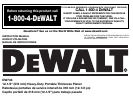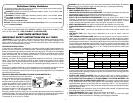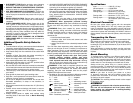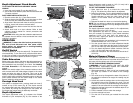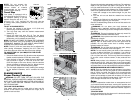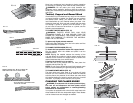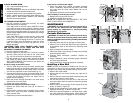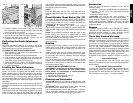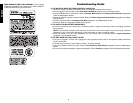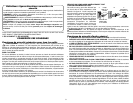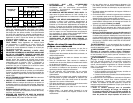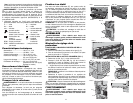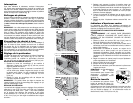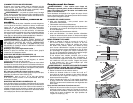
English
1
Definitions: Safety Guidelines
The definitions below describe the level of severity for each signal word. Please read the
manual and pay attention to these symbols.
DANGER: Indicates an imminently hazardous situation which, if not avoided, will
result in death or serious injury.
WARNING: Indicates a potentially hazardous situation which, if not avoided, could
result in death or serious injury.
CAUTION: Indicates a potentially hazardous situation which, if not avoided, may
result in minor or moderate injury.
NOTICE: indicates a practice not related to personal injury which, if not avoided, may
result in property damage.
IF YOU HAVE ANY QUESTIONS OR COMMENTS ABOUT THIS OR ANY DEWALT TOOL,
CALL US TOLL FREE AT:
1-800-4-DEWALT (1-800-433-9258)
SAVE THESE INSTRUCTIONS
IMPORTANT SAFETY INSTRUCTIONS FOR ALL TOOLS
WARNING: For your own safety, read the instruction manual before operating the planer.
Failure to heed these warnings may result in personal injury and serious damage to the
planer. When servicing this tool, use only identical replacement parts. Have damaged cords
replaced by an authorized service center.
GROUNDING INSTRUCTIONS
In the event of a malfunction or breakdown, grounding provides a path of least resistance for
electric current to reduce the risk of electric shock. This tool is equipped with an electric cord
having an equipment-grounding conductor and grounding plug. The plug must be plugged
into a matching outlet that is properly installed and grounded in accordance with all local
codes and ordinances. Do not modify plug provided — if it will not fit the outlet, have the
proper outlet installed by a qualified electrician.
Improper connection of the equipment-grounding conductor can result in a risk of electric
shock. The conductor with insulation having an outer surface that is green with or without
yellow stripes is the equipment-grounding conductor. If repair or replacement of the electric
cord or plug is necessary, do not connect the equipment-grounding conductor to a live
terminal.
Check with a qualified electrician or service personnel if the grounding instructions are not
completely understood, or if in doubt as to whether the tool is properly grounded.
Use only 3-wire extension cords that have 3-prong grounding plugs and 3-pole receptacles
that accept the tool’s plug.
REPAIR OR REPLACE DAMAGED OR WORN CORDS IMMEDIATELY.
This tool is intended for use on a circuit that
A
B
C
GROUNDING PIN
GROUNDED
OUTLET
BOX
GROUNDING
MEANS
ADAPTER
has an outlet that looks like the one illustrated
in FigureA. The tool has a grounding plug
that looks like the plug illustrated in FigureA.
A temporary adapter, which looks like the
adapter illustrated in Figures B and C, may
be used to connect this plug to a 2-pole
receptacle as shown in Figure B if a properly
grounded outlet is not available. The
temporary adapter should be used only until a properly grounded outlet can be installed by a
qualified electrician. The green-colored rigid ear, lug, and the like, extending from the adapter
must be connected to a permanent ground such as a properly grounded outlet box.
The adapter (C) is not for use in Canada.
WARNING: When using electric tools, basic safety precautions should always be followed
to reduce the risk of fire, electric shock, and personal injury, including the following:
General Safety Instructions
• KEEP GUARDS IN PLACE and in working order.
• REMOVE ADJUSTING KEYS AND WRENCHES. Form habit of checking to see that keys
and adjusting wrenches are removed from tool before turning it on.
• KEEP WORK AREA CLEAN. Cluttered areas and benches invite injuries.
• DON’T USE IN DANGEROUS ENVIRONMENT. Don’t use power tools in damp or wet
locations, or expose them to rain. Keep work area well lighted. Always operate tool in a
well-ventilated area free of combustible materials, gasoline or solvent vapors. If sparks
come in contact with flammable vapors, they may ignite, causing fire or explosion.
• KEEP CHILDREN AWAY. All visitors should be kept safe distance from work area.
• MAKE WORKSHOP KID PROOF with padlocks, master switches, or by removing starter
keys.
• DON’T FORCE TOOL. It will do the job better and safer at the rate for which it was
designed.
• USE RIGHT TOOL. Don’t force tool or attachment to do a job for which it was not
designed.
• USE PROPER EXTENSION CORD. Make sure your extension cord is in good condition.
When using and extension cord, be sure to use one heavy enough to carry the current
your product will draw. An undersized cord will cause a drop in line voltage resulting in
overheating and loss of power. The following table shows the correct size to use depending
on cord length and nameplate ampere rating. If in doubt, use the next heavier gauge. The
smaller the gauge number, the heavier the cord. When operating a power tool outside, use
an outdoor extension cord marked “W-A” or “W.” These cords are rated for outdoor use
and reduce the risk of electric shock.
Minimum Gauge for Cord Sets
Ampere Rating
Volts Total Length of Cord in Feet (meters)
120V 25 (7.6) 50 (15.2) 100 (30.5) 150 (45.7)
240V 50 (15.2) 100 (30.5) 200 (61.0) 300 (91.4)
More
Than
Not More
Than
AWG
0 6 18 16 16 14
610 18161412
10 12 16 16 14 12
12 16 14 12 Not Recommended
• WEAR PROPER APPAREL. Do not wear loose clothing, gloves, neckties, rings, bracelets,
or other jewelry which may get caught in moving parts. Nonslip footwear is recommended.
Wear protective hair covering to contain long hair. Air vents often cover moving parts and
should also be avoided.
• ALWAYS USE SAFETY GLASSES. Also use face or dust mask it cutting operation is
dusty. Everyday eyeglasses only have impact resistant lenses, they are not safety glasses.
• ACTUATING TOOL MAY RESULT IN FLYING DEBRIS, COLLATION MATERIAL, OR
DUST WHICH COULD HARM OPERATOR’S EYES. The operator and all those persons
in the general area should wear safety glasses with permanently attached side shields.
Approved safety glasses are imprinted with the characters “Z87.1”. It is the employer’s
responsibility to enforce the use of eye protection equipment by the tool operator and other
people in the work area.
• SECURE WORK. Use of clamps or a vise to hold work when practical. It’s safer than using
your hands and it frees both hands to operate tool.
• DON’T OVERREACH. Keep proper footing and balance at all times.
• MAINTAIN TOOLS WITH CARE. Keep tools sharp and clean for best and safest
performance. Follow instructions for lubricating and changing accessories.



